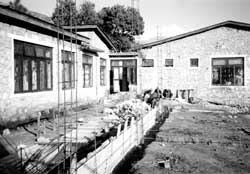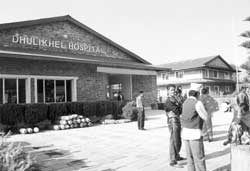 The Lamjung Hospital is, by Nepali standards, sophisticated for such a rural setting. But even more surprising is that this 25-bed hospital is managed entirely by the community it serves. While the rhetoric of "community-participation" has become a development clich? in Nepal, this hospital is anything but. Here is a hospital for the locals, by the locals and of the locals.
The Lamjung Hospital is, by Nepali standards, sophisticated for such a rural setting. But even more surprising is that this 25-bed hospital is managed entirely by the community it serves. While the rhetoric of "community-participation" has become a development clich? in Nepal, this hospital is anything but. Here is a hospital for the locals, by the locals and of the locals.
This new concept of community hospitals in Lamjung and Dhulikhel might be the beginning of a quiet revolution in health care in rural Nepal. Organisations involved in these two hospitals are beginning similar projects in Rukum, Dhading, Kavre and Sindhupalchok. "Delivering health care is easier than it looks-so long as decisions are allowed to be made by local people where the hospitals are being built," says Dr Ram Kantha Makaju, director of Dhulikhel Hospital. The trick is to take the locals into confidence, and let them run it.
Even so, the larger public health picture in Nepal is pretty disastrous. There is on average only one doctor for every 20,000 people. In remote areas-where trained health practitioners rarely work-this ratio is down to one doctor for 100,000.
A 2000 World Bank Study shows that public sector spending on health care, including donor expenditure, is a mere $3.10 per person per year-far less than the $12 needed to provide a basic health care package. The result, the report says, is inadequate hospitals, doctors and service delivery. One high-ranking official at the Department of Health Services told us there is a new problem: "Political instability and interference are destroying the health sector in Nepal. Political patronage make the government employees unaccountable and irresponsible, making the delivery impossible."
The only way to keep health care out of reach of politicians in Kathmandu and to make it affordable is to mobilise local resources to set up and run rural hospitals. So, in 1991, the new National Health Policy was formulated to decentralise health care systems and make them more regionally grounded. Finally, there was a chance that the slogan "Health for all" would not just remain a slogan.
The first step was to hand over sub health posts, the most basic health care units in nearly every one of Nepal's 4,000 village development committee (VDCs), to community management.
 That process is still underway. But bigger initiatives are already coming up. The new hospitals in Lamjung and Dhulikhel are two exemplary, and different, models of community hospitals. Both aim to deliver inexpensive services and be self-sustaining. And though they are more expensive than government-run institutions, they are cheaper than the private clinics and hospitals in Kathmandu Valley and other cities that residents of these areas would have to come down to.
That process is still underway. But bigger initiatives are already coming up. The new hospitals in Lamjung and Dhulikhel are two exemplary, and different, models of community hospitals. Both aim to deliver inexpensive services and be self-sustaining. And though they are more expensive than government-run institutions, they are cheaper than the private clinics and hospitals in Kathmandu Valley and other cities that residents of these areas would have to come down to.
Dhulikhel Hospital is already supporting itself, and offered free or heavily-subsidised treatment worth Rs 3 million last year. And in its four months of operation, the new management of Lamjung Hospital generated 70 percent of the centre's running cost from services and sale of medicine, despite the 30 percent subsidy on all hospital services and drugs. Administrators in Lamjung told us they hope the hospital to be able to support itself in just two more months.
The handover of Lamjung District Hospital to the community was in keeping with official policy to make local level health care units more autonomous, and give them a more prominent role in the planning and management of curative and preventive health services.
Presently, Human Development and Community Service (HDCS), a national NGO, is helping a local non-governmental group, the Lamjung Integrated Community Health Centre to revitalise the formerly government-run district hospital. The new management was given Rs 10 million worth of infrastructure and about over 1.5 hectares of land. HDCS, a sectarian organisation funded by European Christian groups, plans to spend Rs 93 million on renovation and new buildings and Rs 25.7 million on hospital equipment.  Since it is a government health institution, the Lamjung Hospital is entitled to receive Rs 1.5 million and three health personnel including a doctor, and the community itself plans to start a kitchen to raise money for an endowment fund. The maternity and children's wards are under construction, and the general ward is already operational. Soon, the administrators hope to double the hospital's capacity to 50.
Since it is a government health institution, the Lamjung Hospital is entitled to receive Rs 1.5 million and three health personnel including a doctor, and the community itself plans to start a kitchen to raise money for an endowment fund. The maternity and children's wards are under construction, and the general ward is already operational. Soon, the administrators hope to double the hospital's capacity to 50.
"We are here to serve the people and share the burden of health services with the government. Our policy is to complement and improve what is already here rather than funding new infrastructure," says Dr Tirtha Thapa, executive director of HDCS.
In five years the HDCS will bow out and the Lamjung Integrated Community Health Centre will be fully responsible for the hospital. This model holds hope for people at the village and district level, and the HDCS has received requests to help revitalise existing health facilities in six other districts. A year from now, the organisation hopes to begin work on the Chaurjahari Hospital in Rukum.
The Dhulikhel Hospital in Kavre is a little different-it was started by local residents in 1996. Twenty-four Dhulikhel farmers donated 2.2 hectares of land, and the hospital itself was set up with support from the Dhulikhel Municipality, a consortium of European donors called Nepal Made, and the Dhulikhel Health Service Association. Locals contributed Rs 6 million, matched by a municipality grant, to create an endowment fund.
Since the Dhulikhel Hospital is a non-governmental initiative, it does not receive government grants, although it is given customs breaks on the import of equipment. It wouldn't work in a less prosperous district either-it is far too expensive-but the Dhulikhel Hospital is successful enough that it runs four satellite hospitals in Kavre, Dhading and Sindhupalchok.
To be sure, neither of these hospitals is entirely problem-free. For one, both rely on assistance from international donors, which doesn't make them completely self-sustaining. Dhulikhel Hospital is lucky because it has a high proportion of local staff and does not encourage foreign doctors or health workers to stay for long. This puts it in a position to develop the human resources it will need when it expands from 70 beds to 130 in 2004. Since it is the brainchild of one man, Dr Ram Kantha Makaju, there may be questions about its long-term survival.
Its Christian identity may be an obstacle for Lamjung Hospital in establishing the sense of local ownership required for any successful community enterprise. Its dependence on bideshi doctors is another drawback-when we visited the hospital it was being run by four foreign doctors, without any Nepali doctors.
Sharad Onta of the Public Health Concern Trust (PHECT) warns of other problems. "Handing over the management to local institutions and communities without preparations, without training to enhance their abilities, might mean a bigger public health disaster."
This is a potential pitfall when local communities are not consulted right at the start.
But government officials dismiss Onta's concerns. "We are not forcing them to take over the management of sub health posts, but we will allow them to when they feel they are ready for the responsibility," counters Dr DB Chataut, director general of the Department of Health Services.
An analysis of the health sector done by the department in 1999 showed that equitable access to healthcare remained elusive for most Nepalis. The main obstacles: weak management of public health facilities and institutions, inadequate compliance with existing guidelines, a near absence of quality of care protocols,
and poorly defined roles and responsibilities for health authorities.
Chataut says the Lamjung and Dhulikhel models offer new hope. He says: "We hope to involve local communities in management and encourage them to monitor care."


